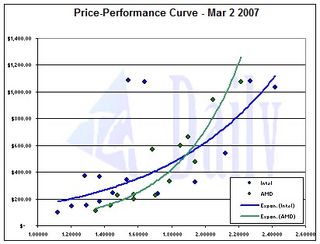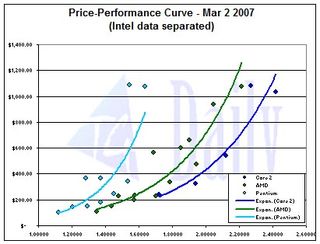Price/performance analysis

Graphically, the addition of the 5600+ and 6000+ did not have a huge impact on AMD's processors in our chart. They actually fit right in with the previous AMD processors, which indicates that they are priced just in line with all other X2 processors. In the graph, we can see that they actually don't really compete with Intel too much because Intel doesn't not have multiple processors with the comparable level of performance. (We need to note that we are still waiting for benchmark data for Intel's Core 2 Duo E6300 processor, which we will provide as soon as it is available to us.)
An interesting development that is highlighted by our charts is the fact that AMD is taking more and more charge of the low-end and high-volume segment of the dual-core processor market at this time. For the first time, we can see that every single processor up to the 5000+, looking at performance, is less expensive in average retail pricing than all the Intel CPUs in or around the same level of performance.

We have mentioned before that when we cut Intel into Pentium D and Core 2 divisions, AMD ends up getting sandwiched between those two processor families. That is especially the case this week. With the exception of the 5000+ and the E6400, which are touching each other on the graph, the three different sets of data are completely separated from one another.
Since it's the only processor for AMD with such a high performance level, the FX-72 has a huge impact on the high end of AMD's trendline. If it continues to fall in price like it's been doing for the past six weeks, it could actually start putting pressure on Intel on the high end. This is certainly something to be watching over the next weeks.
Stay on the Cutting Edge
Join the experts who read Tom's Hardware for the inside track on enthusiast PC tech news — and have for over 25 years. We'll send breaking news and in-depth reviews of CPUs, GPUs, AI, maker hardware and more straight to your inbox.
Most Popular


